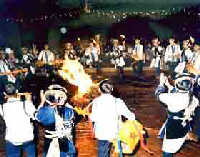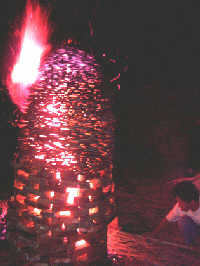Customs

The main activities on the Mid-Autumn Festival are appreciating the full moon and eating moon cakes as mentioned in the origin of the Mid-Autumn Festival. Since China is a big country with a large population, the festival tends to be celebrated in various ways, with each way having its own strong local flavor.
In Fucheng County of East China's Fujian Province, when the Mid-Autumn Festival began, the local women will cross the Nanpu Bridge in an attempt to seek longevity. In Jiannin County, lanterns are hung as a gesture to pray for pregnancy from the Moon. When people in Longyan County eat moon cakes, they often scratch a hole in the center of a moon cake for the elderly, signifying the withholding of secrets from the younger generations.
The custom of worshipping the moon on the Mid-Autumn day also prevails in the Chaozhou and Shantou regions of South China's Guangdong Province, mainly for women and children, as a proverb goes, "Men will not worship the full moon, nor will women worship the kitchen range." As night falls and the moon rises, the women will lay a table in the courtyard, with burning incenses and sacrifices, such as fruits and cakes, on it, to worship the moon in the sky. There is also the custom of eating taros on the festival, as August is the time for harvesting taros.

In the South of the Yangtze River, the Mid-Autumn customs also boast large varieties. Apart from moon cakes, a Guihua Duck, a famous local dish, will surely be served on the dining table that night. Besides, there are interesting names for different Mid-Autumn activities, such as: "Qing Tuan Yuan" (celebrating reunion), referring to families appreciating the full moon together; drinking together; "Yuan Yue" (worshipping the moon); and "Zou Yue" (walking the moon), which refers to going out together.
In Ji'an County of East China's Jiangxi Province, earthen jars will be burned with straw in every village in the evening of the Mid-Autumn Festival. When the jars get red hot, vinegar will be poured in, permeating the whole village in a delicate fragrance.
When the Mid-Autumn Festival sets in Ziyuan County of East China's Anhui Province, the local children will get together to build a hollow pagoda with bricks and tiles, decorated with veiling and steles, and so on. Then, a table is placed in front of the pagoda, with various sacrifices meant to worship the "god of pagoda." During the night, burning candles will be placed both inside and outside the pagoda.
People in Southwest China's Sichuan Province usually eat duck, sesame cakes, and honey cakes in addition to moon cakes. In some places, "orange lights" are hung on the doors for celebration.
In Xixiang County of North China's Shaanxi Province, men go boating or climbing while women arrange for the feast on the night of the Mid-Autumn Festival and every one, poor or rich, has to eat watermelon. Besides, suona (a kind of Chinese wind instrument) or drum players will often perform door by door on that day, begging for money as a reward.










